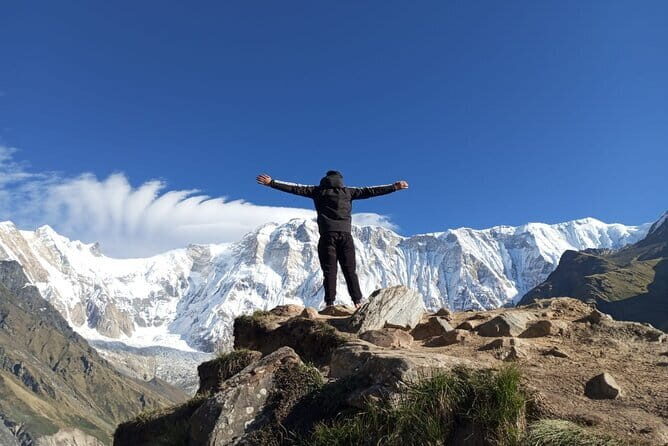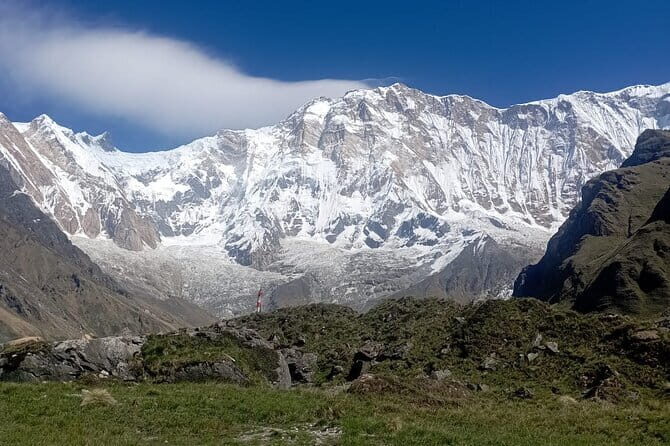Annapurna Base Camp Trek – A Detailed Look at Nepal’s Best Trekking Experience
If you’ve ever dreamed of walking amidst some of the world’s highest peaks, the Annapurna Base Camp (ABC) Trek offers a captivating mix of nature, culture, and adventure. Priced at $500 per person for about 10 days of trekking, this guided journey takes you from lush forests and charming villages to the awe-inspiring Annapurna Sanctuary. Guided by local experts, you’ll explore Nepal’s heartland with personalized attention, ensuring a journey that’s as safe and smooth as it is breathtaking.
What we love most about this trek are the personalized guides who are native to the region, offering insights you won’t find on a map and helping you navigate the high-altitude challenges. The second highlight is the diversity of scenery—from the verdant rhododendron forests to the panoramic views from Poon Hill—making every day feel like a new chapter in your Himalayan story.
However, it’s worth noting that this trek demands a moderate level of fitness, with long days on foot and some steep ascents. It’s not a casual stroll but a well-paced adventure suited for those prepared to walk daily for several hours, sometimes in rugged terrain.
This tour is perfect for adventurous travelers who want an authentic experience guided by local experts, and who appreciate the cultural richness and natural beauty of Nepal’s Annapurna region. Whether you’re a seasoned trekker or a first-timer seeking a manageable challenge, the detailed itinerary and supportive guides will help you make the most of your time in the mountains.
Key Points

- Authentic local guides with extensive experience ensure safety and cultural insights.
- Stunning mountain views at Poon Hill and Annapurna Base Camp offer memorable photo opportunities.
- Balanced itinerary with a mix of trekking, sightseeing, and rest days suits different fitness levels.
- All logistics handled from permits to accommodations, simplifying your adventure.
- Affordable price point offers great value for a comprehensive 10-day trek in the Himalayas.
- Authentic cultural experiences in local villages enhance your understanding of Nepali life.
Overview of the Annapurna Base Camp Trek

The trek starts in Kathmandu, where we are picked up and transferred to Pokhara, a scenic lakeside city that acts as the gateway to the mountains. Over about 7 hours, the drive follows the tranquil Trishuli River, giving us a sneak peek into the lush landscapes ahead. We love the balance of road travel and the anticipation it builds for the adventure to come. It’s a good way to acclimate and shake off city stress.
The real walking begins on Day 2 with a drive to Nayapul, then a trek through charming villages along the Modi Khola River. Here, we’re introduced to Nepalese rural life, with stone-paved streets and friendly locals. The ascent to Ulleri is quite steep but rewarding, offering a glimpse of the traditional stone houses and sweeping mountain vistas.
Love the outdoors? Here are other hiking experiences we've covered in Kathmandu
Day 1: Arrival and Transfer to Pokhara
- Highlights: Scenic drive, lakeside evening stroll
- What’s special: The landscape shifts from Kathmandu’s chaos to Pokhara’s serene beauty, a perfect start for your trek.
Day 2: Trek to Ulleri
- Highlights: Riverside walk, village life, mountain views
- Experience: The trek’s gentle start, followed by a steady climb through terraced fields and local villages, sets the tone for the days ahead.
Day 3: Ulleri to Ghorepani
- Highlights: Forest scenery, panoramic views of Annapurna range
- Tip: We loved the lush forests and the option to enjoy some local tea houses along the way.
Day 4: Poon Hill Sunrise & Trek to Tadapani
- Highlights: Sunrise over the Himalayas, rhododendron forests
- Special: Watching the dawn light hit the peaks from Poon Hill is truly unforgettable, often cited as the trek’s highlight.
Day 5: Tadapani to Sinuwa
- Highlights: Forest walks, mountain views
- Authentic: The trail through rhododendrons and bamboo offers a peaceful, natural experience.
Day 6: Sinuwa to Deurali
- Highlights: Forested ascent, crossing Khumbu Glacier
- Tip: The landscape becomes more rugged here, with fantastic mountain vistas and fewer trekkers.
Day 7: Deurali to Annapurna Base Camp
- Highlights: Trail through Machapuchare Base Camp, towering peaks surrounding your camp
- Experience: Standing at the foot of Annapurna I, surrounded by mountains over 8,000 meters, makes all the effort worthwhile.
Day 8: Return to Sinuwa
- Highlights: Reflective descent, familiar trails
- Review: “The ABC trek was tough, but totally worth it,” says a traveler, emphasizing the rewarding challenge.
Day 9: Trek to Jhinu and drive back to Pokhara
- Highlights: Relaxing in hot springs, lakeside evening in Pokhara
- Tip: The hot springs near Jhinu are a perfect way to soothe tired muscles.
Day 10: Return to Kathmandu
- Highlights: Scenic drive or short flight, last-minute shopping or sightseeing
- Tip: The drive back offers a final chance to enjoy Nepal’s landscapes before returning home.
The Experience: What Makes It Special?
Guided by local Nepalese experts, the guides are more than just navigators—they’re storytellers and cultural ambassadors. Multiple reviews praise guides like Madan and Roshan for their helpfulness, friendliness, and knowledge, which greatly enriches the trek. Their familiarity with the terrain and local culture helps you appreciate the villages’ ways of life and the mountain’s grandeur.
The scenery is what every trekker dreams of: terraced fields, lush forests, and panoramic mountain views. The sunrise from Poon Hill is a highlight — a moment where the sky ignites in hues of orange and pink, illuminating the snow-capped peaks. During the trek, you’ll pass through forests of rhododendron, which bloom in spring, adding bursts of color.
Value for money is another key strength. At $500, the trek includes all permits, accommodations, and guiding services, making it a hassle-free adventure. You get the convenience of logistics handled by seasoned locals who prioritize your safety and comfort.
Cultural immersion is another benefit. Visiting small villages and interacting with local families gives you a genuine sense of Nepali life. The trek isn’t just about mountains; it’s about connecting with the land and its people.
Notable in reviews is the friendly, professional staff. Travelers frequently mention how guides and porters go above and beyond to ensure a positive experience — from managing high-altitude challenges to sharing local stories.
What to Expect at Each Stop

Each stage offers a unique mix of natural beauty and local culture. In Ulleri, you’re walking through terraced fields with mountain vistas on the horizon. In Ghorepani, you’ll find yourself surrounded by rhododendron forests and small tea houses where you can relax. Poon Hill is a morning ritual — waking early to catch the sunrise that lights up the Himalayas.
Tadapani offers a quiet village atmosphere, away from crowds, perfect for soaking in the mountain views. As you descend into Sinuwa and Deurali, the landscape shifts from lush forests to more rugged, alpine terrain with sweeping vistas. At Annapurna Base Camp, the sense of achievement is palpable, with towering peaks on all sides.
Descending back, your legs will feel the effort, but the views and memories will stay with you. The hot springs near Jhinu provide a well-deserved break, and the drive back to Pokhara offers a chance to reflect on the journey.
Practical Details and Tips

- Transportation: From Kathmandu, the trek begins with a bus or flight to Pokhara, followed by a drive to Nayapul, then walking. The return is a trek down to Jhinu, then a short drive to Pokhara.
- Group Size: The tour is private, so only your group participates, which means personalized attention.
- Permits and Fees: All necessary permits and fees are included, removing any last-minute surprises.
- Meals: You’ll enjoy breakfast, lunch, and dinner at tea houses along the route. We recommend bringing light snacks or chocolates for extra energy.
- Clothing: Pack layers suitable for high-altitude weather — it can be warm during the day and cold at night.
- Physical Fitness: A moderate level of fitness is advisable; the trek involves some steep ascents and long walking hours.
- Essential Gear: Water bottles, sun glasses, chargers, and a good backpack are must-haves.
Final Thoughts: Who Is This Trek Best For?

This trek suits travelers who want an authentic Himalayan adventure with the reassurance of knowledgeable guides. It appeals to those who value culture, stunning scenery, and value for money. If you’re prepared for several hours of walking each day and want a well-organized itinerary, this trek offers a rewarding challenge.
Travelers who found the guides helpful and friendly in reviews will appreciate the personalized attention. It’s ideal if you want a moderate trek that covers iconic sights like Poon Hill and Annapurna Base Camp without requiring advanced mountaineering skills. Families, first-time trekkers, or seasoned hikers seeking a manageable challenge will all find something to love here.
FAQ

How long is the trek?
It’s approximately 10 days, including travel, trekking, and recovery time.
Is this trek suitable for beginners?
Yes, with moderate fitness and a positive attitude, most beginners can enjoy this trek, especially with guides managing high-altitude concerns.
What is the cost?
The price is $500 per person, which includes permits, accommodations, guides, and most meals.
What do I need to bring?
Pack layers for variable weather, water bottles, sun glasses, chargers, and personal essentials. Light snacks are recommended for energy.
Are meals included?
Yes, breakfast, lunch, and dinner are provided during the trek at tea houses.
Can I customize the itinerary?
This is a private tour, so modifications are possible with prior notice.
What is the best time to go?
While not explicitly stated, most Himalayan treks are best in spring and autumn for clear skies and mild weather.
How are the guides?
Highly praised in reviews for their knowledge, helpfulness, and friendly demeanor.
What about altitude sickness?
Guides manage acclimatization carefully, and the gradual ascent helps reduce risks.
How do I get back to Kathmandu?
Either a scenic drive (about 7-8 hours) or a short flight, both options are available at the end of the trek.
To sum it up, the Annapurna Base Camp Trek guided by Touch The Himalaya offers a well-rounded, authentic Himalayan experience. It’s suited for travelers seeking a mix of natural beauty, local culture, and expert guidance without breaking the bank. The stunning scenery, friendly guides, and thoughtfully organized itinerary all contribute to a trek that’s memorable for the right reasons. Whether you’re after a first Himalayan adventure or looking to tick a classic off your bucket list, this trek is worth considering.
More Hiking & Trekking Tours in Kathmandu
More Tour Reviews in Kathmandu
More Kathmandu experiences we've covered
- Kathmandu: Discovering Kirtipur’s Hidden Treasures City Walk
- Kathmandu to Bhairahawa / Lumbini Scenic Flight
- Exclusive Kathmandu Food Tour Epic local foods
- Everest base camp helicopter tour
- Everest Mountain Flight tour From Kathmandu – Daily Departures
- Dhaulagiri Circuit Trek – 17 Day
- Cycling Tour in Kathmandu – Day Tour
- Kathmandu: Private/Group Unesco Heritage Sites Guided Tour
- Kathmandu Valley trek with sightseeing
- From Pokhara: 4-Day Mardi Himal Trek and 2-Day Chitwan
- Lumbini Pilgrimage Tour by Flight- 2 Days
- Bhaktapur & Patan Durbar Square Day Tours
